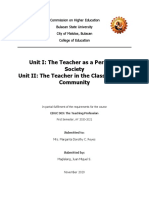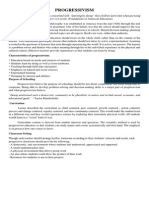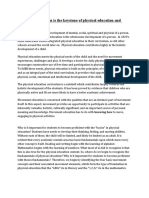0 ratings0% found this document useful (0 votes)
24 viewsPhilosophy Table
Philosophy Table
Uploaded by
nestor villarosaThis document outlines different philosophies of education including essentialism, perennialism, progressivism, existentialism, behaviorism, constructivism, and reconstructionism. Each philosophy is described in terms of why education is important, what should be taught, and how instruction should be delivered. For example, essentialism focuses on gaining fundamental knowledge and teaches basic skills through direct instruction from teachers acting as role models. Progressivism aims to develop democratic citizens and emphasizes experiential learning through hands-on activities. Reconstructionism places importance on social reform and building a better society by informing students about problems and encouraging action.
Copyright:
© All Rights Reserved
Available Formats
Download as DOCX, PDF, TXT or read online from Scribd
Philosophy Table
Philosophy Table
Uploaded by
nestor villarosa0 ratings0% found this document useful (0 votes)
24 views2 pagesThis document outlines different philosophies of education including essentialism, perennialism, progressivism, existentialism, behaviorism, constructivism, and reconstructionism. Each philosophy is described in terms of why education is important, what should be taught, and how instruction should be delivered. For example, essentialism focuses on gaining fundamental knowledge and teaches basic skills through direct instruction from teachers acting as role models. Progressivism aims to develop democratic citizens and emphasizes experiential learning through hands-on activities. Reconstructionism places importance on social reform and building a better society by informing students about problems and encouraging action.
Original Description:
aSxszczxc
Copyright
© © All Rights Reserved
Available Formats
DOCX, PDF, TXT or read online from Scribd
Share this document
Did you find this document useful?
Is this content inappropriate?
This document outlines different philosophies of education including essentialism, perennialism, progressivism, existentialism, behaviorism, constructivism, and reconstructionism. Each philosophy is described in terms of why education is important, what should be taught, and how instruction should be delivered. For example, essentialism focuses on gaining fundamental knowledge and teaches basic skills through direct instruction from teachers acting as role models. Progressivism aims to develop democratic citizens and emphasizes experiential learning through hands-on activities. Reconstructionism places importance on social reform and building a better society by informing students about problems and encouraging action.
Copyright:
© All Rights Reserved
Available Formats
Download as DOCX, PDF, TXT or read online from Scribd
Download as docx, pdf, or txt
0 ratings0% found this document useful (0 votes)
24 views2 pagesPhilosophy Table
Philosophy Table
Uploaded by
nestor villarosaThis document outlines different philosophies of education including essentialism, perennialism, progressivism, existentialism, behaviorism, constructivism, and reconstructionism. Each philosophy is described in terms of why education is important, what should be taught, and how instruction should be delivered. For example, essentialism focuses on gaining fundamental knowledge and teaches basic skills through direct instruction from teachers acting as role models. Progressivism aims to develop democratic citizens and emphasizes experiential learning through hands-on activities. Reconstructionism places importance on social reform and building a better society by informing students about problems and encouraging action.
Copyright:
© All Rights Reserved
Available Formats
Download as DOCX, PDF, TXT or read online from Scribd
Download as docx, pdf, or txt
You are on page 1of 2
TC 313 – ACTIVITY 3
PHILOSOPHY WHY TEACH? WHAT TO TEACH HOW TO TEACH?
» To gain fundamental » Basic skills » Highlighting the
knowledge, skills, » Fundamental R’s subject's mastery.
ESSENTIALISM and values. » Contains classic » Held up as
subjects including intellectual and
math, the natural ethical role models
sciences, history, for their students.
foreign languages,
and literature.
» To develop student’s » The perennialist » Teachers do not let
rational and moral curriculum is based the experiences or
PERENNIALISM powers. on the idea that all interests of their
» Belief in the people share a students heavily
importance of reason common basic influence what they
and in people's essence. teach.
capacity for » Heavy on humanities
evaluating the and general
goodness of things education.
based on reason. » Great books.
» To mold students » Need-based and » Employ experiential
into knowledgeable, relevant curriculum. methods. They
educated members » Teaching the learners believe that one
PROGRESSIVISM of a democratic the skills to cope learns by doing.
society. change. (John Dewey)
» Emphasize to » Natural and social » “Hands-on-minds-
students that living sciences. on” teaching
completely in the methodology.
now is more
important than
preparing them for
adulthood.
» To encourage » Gives a wide variety » Focuses on the
children to recognize options from which individual.
EXISTENSIALISM and value themselves to choose. » Learning is self-
as distinctive » Emphasis on the paced, self-directed.]
individuals who take humanities. » Individual contact
full responsibility for » Vocational education with the teacher.
their feelings, to teach children
thoughts, and about themselves
actions. and their potentials.
» Student’s behaviour » Teach students to » Sets up the
is a product of his respond favourably surrounding
BEHAVIORISM environment. to various stimuli in environment so that
the environment. students can react to
stimuli.
» Teach students » Consist of learner- » Set up scenarios that
critical thinking and centered, active encourage students
CONSTRUCTIVISM creates active and instruction. to question their own
motivated learners. and one another's
presumptions.
» It places a strong » A curriculum that » Informs students
TC 313 – ACTIVITY 3
emphasis on highlights social about the nature and
RECONSTRUCTIONISM addressing social reform as the aim of the extent of the
issues and working to education. problem and
build a better society suggests what one
and global can do about these
democracy. problems.
Zapanta, Shera Niña C. BSED-3A September 25, 2022
You might also like
- Table of PhilosophiesDocument2 pagesTable of Philosophiesbarliz33% (3)
- Chemistry CurriculumDocument8 pagesChemistry CurriculumKevon KbulimoNo ratings yet
- Isnain, Erich C - BSED 1A 08/22/2020: Educational Philosophy Philosophical Roots Idealism Realism PragmatismDocument3 pagesIsnain, Erich C - BSED 1A 08/22/2020: Educational Philosophy Philosophical Roots Idealism Realism PragmatismErichIsnainNo ratings yet
- Why Teach What To Teach How To Teach: EssentialismDocument2 pagesWhy Teach What To Teach How To Teach: EssentialismSunako Claes0% (1)
- Philosophies of EducationDocument6 pagesPhilosophies of EducationJake FundalNo ratings yet
- Educational PhilosophiesDocument30 pagesEducational PhilosophieseszletootNo ratings yet
- EDUC 3 LECTURE SEVEN PHILOSOPHIES of EDUCATIONDocument5 pagesEDUC 3 LECTURE SEVEN PHILOSOPHIES of EDUCATIONAlexie Anne MariñoNo ratings yet
- Philosophical Thoughts On EducationDocument15 pagesPhilosophical Thoughts On EducationSittie Naifah AliNo ratings yet
- Teacher Education Department: EpistemologyDocument5 pagesTeacher Education Department: EpistemologyIvanne MeinelNo ratings yet
- Michael Behnke ZineDocument4 pagesMichael Behnke Zineapi-533367587No ratings yet
- The 7 Philosophies of EducationDocument4 pagesThe 7 Philosophies of EducationJonamay CarantoNo ratings yet
- Education Is A Realization of PotentialDocument16 pagesEducation Is A Realization of PotentialSein RatiozineirungNo ratings yet
- Teaching Profession AssignmentDocument2 pagesTeaching Profession Assignmentjunjun gallosa100% (6)
- Discuss Briefly Your Own Understanding of Philosophy and Its Importance in Teaching. Give Examples or Real Life ExperiencesDocument8 pagesDiscuss Briefly Your Own Understanding of Philosophy and Its Importance in Teaching. Give Examples or Real Life Experiencesjhun ecleoNo ratings yet
- The Teaching Profession Chapter One: You, The Teacher, As A Person in The SocietyDocument4 pagesThe Teaching Profession Chapter One: You, The Teacher, As A Person in The SocietyMargareth DaacaNo ratings yet
- Table of PhilosophiesDocument4 pagesTable of PhilosophiesChester Llemos PalmonesNo ratings yet
- AJENTH JACEL ARO EDUC103 Philosophy of EducationDocument2 pagesAJENTH JACEL ARO EDUC103 Philosophy of EducationajenthjacelramosaroNo ratings yet
- STI - Explore - TasksDocument5 pagesSTI - Explore - TasksSandra IsraelNo ratings yet
- Mangahas, James Moses (Bped 3-A)Document49 pagesMangahas, James Moses (Bped 3-A)James Sanchez MangahasNo ratings yet
- Learning With Action Research ReportDocument8 pagesLearning With Action Research ReportGelgel DecanoNo ratings yet
- ASSIGNMENT #3 - Matrix of The Different PhilosophiesDocument6 pagesASSIGNMENT #3 - Matrix of The Different Philosophiesngitngit.jjtNo ratings yet
- Educ 201 Philo MAEdDocument4 pagesEduc 201 Philo MAEdQueenie Rose AmadorNo ratings yet
- Philosophy of Perennialism: Presented By: Ater, Nikko Cocamao, Judelyn Helia, Edelyn Palo, Jehan Pantao, NashibaDocument16 pagesPhilosophy of Perennialism: Presented By: Ater, Nikko Cocamao, Judelyn Helia, Edelyn Palo, Jehan Pantao, NashibaStarNo ratings yet
- Psychological and Philosophical Foundation of EducationDocument5 pagesPsychological and Philosophical Foundation of EducationEMEE T. BASCONo ratings yet
- Challenge 3 Philophies of EducationDocument3 pagesChallenge 3 Philophies of EducationDiane RomeroNo ratings yet
- ProEd 6Document1 pageProEd 6Jirah Joy PeañarNo ratings yet
- Idealism Realism Pragmatism/ Experimentalism Essentialism Perennialism Progressivism Social Reconstructionism ExistentialismDocument2 pagesIdealism Realism Pragmatism/ Experimentalism Essentialism Perennialism Progressivism Social Reconstructionism ExistentialismRey Pineda100% (1)
- Perennial Is MDocument24 pagesPerennial Is MRamil Gofredo100% (1)
- Philosohical Thoughts/Doctorines Vis-Avis EducationDocument3 pagesPhilosohical Thoughts/Doctorines Vis-Avis EducationEddie Jr SadamoNo ratings yet
- The 7 Philosophies of EducationDocument23 pagesThe 7 Philosophies of EducationJonamay Dela RosaNo ratings yet
- Culturally Relevant Pedagogy Explained... : CRP Is A Teaching Framework Developed by Dr. Gloria Ladson-BillingsDocument1 pageCulturally Relevant Pedagogy Explained... : CRP Is A Teaching Framework Developed by Dr. Gloria Ladson-BillingsMarcela MontesNo ratings yet
- Seven Philosophies of Education Philosophies Why Teach What To Teach How To Teach EmphasisDocument6 pagesSeven Philosophies of Education Philosophies Why Teach What To Teach How To Teach EmphasisFranz Simeon ChengNo ratings yet
- Activity 1 Matrix of Major PhilosophiesDocument2 pagesActivity 1 Matrix of Major PhilosophiesHeart Wp100% (2)
- Exercise #1 Educational Philosophies: Prof. Ed. 533 - The Teaching Profession and Social Dimension of EducationDocument3 pagesExercise #1 Educational Philosophies: Prof. Ed. 533 - The Teaching Profession and Social Dimension of EducationLouise salesNo ratings yet
- Philosophies of Education MatrixDocument4 pagesPhilosophies of Education MatrixCesar Patac100% (1)
- Kapu YaaaaDocument6 pagesKapu YaaaaJenny Rose BaculadNo ratings yet
- 548f22785d3c316af5b3282b624571beda9fDocument6 pages548f22785d3c316af5b3282b624571beda9fghadaNo ratings yet
- Module1 Task5to5 HuelarDocument5 pagesModule1 Task5to5 Huelaryvonne.floritaNo ratings yet
- Unit I: The Teacher As A Person in Society Unit II: The Teacher in The Classroom and CommunityDocument63 pagesUnit I: The Teacher As A Person in Society Unit II: The Teacher in The Classroom and CommunityJuan Miguel Salvador MaglalangNo ratings yet
- Tugasan Kuliah - Perkembangan Falsafah Pendidikan BaratDocument5 pagesTugasan Kuliah - Perkembangan Falsafah Pendidikan BaratFiona TiehNo ratings yet
- Prof. Ed 13 - The Teaching Profession Modular Lesson No. 2Document4 pagesProf. Ed 13 - The Teaching Profession Modular Lesson No. 2Mish LimNo ratings yet
- Learning Task:: Children Should Learn The Traditional Basic Subjects ThoroughlyDocument2 pagesLearning Task:: Children Should Learn The Traditional Basic Subjects ThoroughlyKhyle Acebron RizalNo ratings yet
- The 7 Philosophies of EducationDocument25 pagesThe 7 Philosophies of EducationJonamay CarantoNo ratings yet
- profED2 1-10Document15 pagesprofED2 1-10Mikee SantoNo ratings yet
- ProgressivismDocument5 pagesProgressivismZyra Catherine Morales100% (1)
- Lesson 2 PhiloPsychoDocument32 pagesLesson 2 PhiloPsychoKisha Trixie FernandoNo ratings yet
- Part 3: On The CurriculumDocument2 pagesPart 3: On The Curriculumflory mae gudiaNo ratings yet
- Activity #2 FinalDocument6 pagesActivity #2 FinalAlna Gamulo LosaNo ratings yet
- Learning ModelsDocument31 pagesLearning ModelsYudi YanasyifaNo ratings yet
- EDUC 101: Philosophy of Education Final Exam Submitted By: Charis M. Alejo Submitted To: Aida M. Ricarze, PH.DDocument6 pagesEDUC 101: Philosophy of Education Final Exam Submitted By: Charis M. Alejo Submitted To: Aida M. Ricarze, PH.Dcharis m. alejoNo ratings yet
- Comparing Learning TheoriesDocument8 pagesComparing Learning Theoriesfimmee2006No ratings yet
- A Science Teachers Guide To Multiliteracies PedagogyDocument1 pageA Science Teachers Guide To Multiliteracies Pedagogyapi-531527240No ratings yet
- Activity #2@Document8 pagesActivity #2@roseann.callada02No ratings yet
- Arial Philosophies-of-Education-MatrixDocument4 pagesArial Philosophies-of-Education-MatrixBing RodriguezNo ratings yet
- Lagata, Rhealyn Gupit. MatrixDocument19 pagesLagata, Rhealyn Gupit. MatrixRash MI ER LagataNo ratings yet
- Philosophy of Education Second ActivityDocument5 pagesPhilosophy of Education Second Activitymaria1jennizaNo ratings yet
- The Teaching Profession - Activity 2 - Pbte1-1 - CaladDocument2 pagesThe Teaching Profession - Activity 2 - Pbte1-1 - CaladJohn Michael Alejandro CaladNo ratings yet
- Philosophical MatrixDocument3 pagesPhilosophical MatrixIvy Jean Amadora FelicianoNo ratings yet
- Essentailis M Perennialis M Progressivis M Sosial Reconstructio N Behaviouris M ExistentialismDocument2 pagesEssentailis M Perennialis M Progressivis M Sosial Reconstructio N Behaviouris M ExistentialismNARMATHA A/P LINGAM (L221161032)100% (1)
- 5 Educational Learning Theories and How To Apply ThemDocument6 pages5 Educational Learning Theories and How To Apply Themvirginianadayag.spcNo ratings yet
- Determination of Pre-Service Chemistry Teachers TSPCK in Mole Concept in Abubakar Tafawa Balewa University Bauchi StateDocument8 pagesDetermination of Pre-Service Chemistry Teachers TSPCK in Mole Concept in Abubakar Tafawa Balewa University Bauchi StateInternational Journal of Innovative Science and Research TechnologyNo ratings yet
- MAPEHDay 2Document5 pagesMAPEHDay 2reaasidNo ratings yet
- 519 - Week 4 Internship ReflectionDocument3 pages519 - Week 4 Internship Reflectionapi-551836854No ratings yet
- DLL Math HiligaynonDocument9 pagesDLL Math HiligaynonJhon mark CanelaNo ratings yet
- Irfan AliDocument37 pagesIrfan Alishoukat aliNo ratings yet
- Institutional Graduate Outcomes Attributes Link To MV-CV Common To All Programs in All Types of SchoolDocument7 pagesInstitutional Graduate Outcomes Attributes Link To MV-CV Common To All Programs in All Types of SchoolLemuel AyingNo ratings yet
- Philosophy of TeachingDocument64 pagesPhilosophy of TeachingMaria Theresa AlcantaraNo ratings yet
- Montgomery County 2008 Final UpdateDocument440 pagesMontgomery County 2008 Final UpdateKumar SingamNo ratings yet
- B.Ed 102Document44 pagesB.Ed 102vogedi5897No ratings yet
- 21ST Century EducationDocument7 pages21ST Century EducationmalayrolamesheijoyNo ratings yet
- Kaitlyn Davis: ObjectiveDocument2 pagesKaitlyn Davis: Objectiveapi-242810929No ratings yet
- Philosophy of EducationDocument19 pagesPhilosophy of Educationnosila_oz854No ratings yet
- Ed 193540Document2,123 pagesEd 193540PIYUSHNo ratings yet
- Reseach Proposal-AfidraDocument22 pagesReseach Proposal-AfidraMALISH albertNo ratings yet
- Problem Based LearningDocument5 pagesProblem Based LearningKhairul Salleh BaharudinNo ratings yet
- 9-10 Citizenship T0T ManualDocument33 pages9-10 Citizenship T0T Manualeyaluayssa10qNo ratings yet
- Developing An Evaluation Scale For Assessing The Effective Implementation of Matatag Curriculum in Philippine Public Schools Exploratory SequDocument18 pagesDeveloping An Evaluation Scale For Assessing The Effective Implementation of Matatag Curriculum in Philippine Public Schools Exploratory SequJournal of Interdisciplinary Perspectives100% (10)
- Week 1&2 - Creative WritingDocument7 pagesWeek 1&2 - Creative WritingCarole Amorado Gomez100% (1)
- Literature Matrix TemplateDocument21 pagesLiterature Matrix TemplateKen Stephen RheyNo ratings yet
- Indigenization and Contextualization of The CurriculumDocument6 pagesIndigenization and Contextualization of The CurriculumKean Nue100% (2)
- B B Tayal Political Science Class 12 PDF DownloadDocument3 pagesB B Tayal Political Science Class 12 PDF Downloadbhaijaan3091No ratings yet
- Pontyclun Full ARP 20222023Document12 pagesPontyclun Full ARP 20222023carwyn321No ratings yet
- Module 1 - NC II - Participating in Workplace Communication - HB - 2020.11.23Document81 pagesModule 1 - NC II - Participating in Workplace Communication - HB - 2020.11.23JAMARIE BALUZONo ratings yet
- Social Foundations in Curriculum DevelopmentDocument17 pagesSocial Foundations in Curriculum DevelopmentPax GarciaNo ratings yet
- Curriculum Development Need and Importance (B.Ed. Notes)Document3 pagesCurriculum Development Need and Importance (B.Ed. Notes)Mhuf Badules100% (1)
- Mit Electrical Engineering Curriculum International OverviewDocument40 pagesMit Electrical Engineering Curriculum International OverviewJhon SaldañaNo ratings yet
- Movement Education Is The Keystone of Physical Education and Sport. DiscussDocument6 pagesMovement Education Is The Keystone of Physical Education and Sport. Discusssamanta100% (1)
- PeacDocument2 pagesPeacRona Jane Roa Sanchez100% (2)
























































































